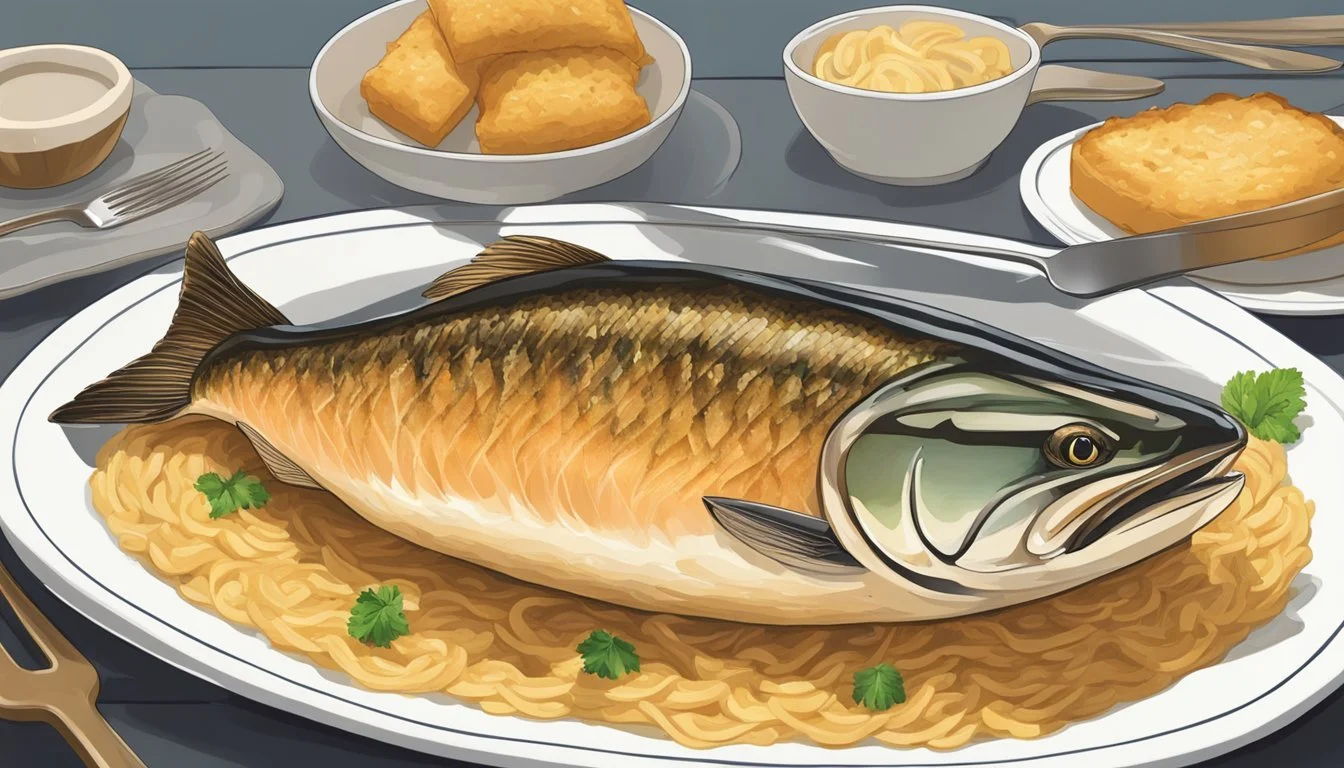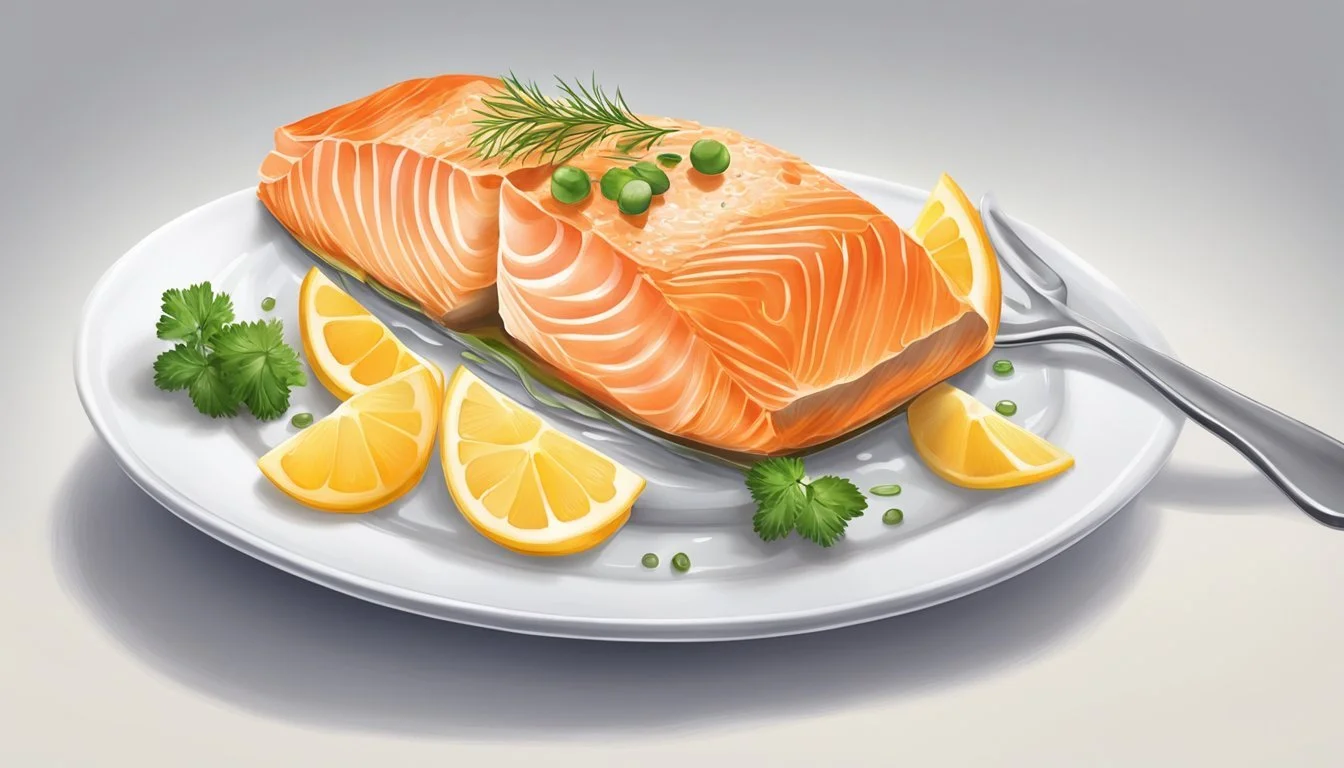Best Way to Reheat Salmon Coulibiac
Ensuring Flaky Pastry Perfection
Reheating Salmon Coulibiac (What wine goes well with salmon?) requires a careful balance between restoring the warmth and texture of the fish and maintaining the flakiness of the surrounding pastry. Salmon Coulibiac, a classic Russian dish that encases salmon in a rich, buttery crust, can be a delightful meal to savor even after its initial serving. The key to successfully reheating lies in the method chosen, ensuring that the salmon remains moist and flavorful while the pastry regains its crispness without becoming soggy or burnt.
The oven is the most recommended reheating option for this delicate dish. It provides a consistent, all-around heat that gently warms the salmon while revitalizing the pastry's flakiness. To achieve the best results, it is important to preheat the oven to a low temperature, typically between 275 to 300 degrees Fahrenheit, before placing the Salmon Coulibiac inside. Covering the dish loosely with foil can help retain moisture in the salmon while the heat works its magic on the pastry, resulting in a harmonious blend of textures.
Care must also be taken not to overheat, as this can dry out the salmon and cause the pastry to harden. Monitoring the dish's internal temperature with a kitchen thermometer can help ensure that it reaches the ideal warmth without compromising the desired qualities of the Salmon Coulibiac. A perfect reheated Coulibiac should offer the warmth and comfort of a freshly baked meal with each component - the salmon and pastry - in its prime.
Understanding Salmon Coulibiac
Salmon Coulibiac is a classic Russian dish that showcases a harmonious blend of salmon and savory fillings wrapped in a flaky pastry crust, requiring precise reheating to maintain its texture and flavors.
Composition and Ingredients
Salmon Coulibiac is characterized by its layers of ingredients, each contributing to the dish's complexity and taste. At its heart lies salmon, typically poached, providing a rich and oily fish base that pairs well with other components. Encasing the salmon is a pastry layer, often puff pastry or brioche dough, which should bake until golden to achieve a flaky exterior.
The internal composition includes a mixture of rice and hard-boiled eggs, adding substance and contrasting textures. Onions, dill, and mushrooms are common aromatic ingredients that infuse the dish with earthy and herbal flavors. Finally, some recipes may suggest the creation of a yeast-based dough or include additional crepes layers to absorb moisture and maintain structure.
Importance of Reheating Correctly
Proper reheating is crucial in Salmon Coulibiac to preserve the pastry's flakiness without drying out the filling. An oven is typically recommended for warming through the dish evenly. The goal is to reach an internal temperature of 145°F (63°C) or until it is steaming hot, often at a moderate temperature of 275°F to 300°F (135°C to 150°C) for about 15 minutes. It ensures that the salmon retains its moisture while the pastry crust revives its crispiness. Reheated correctly, the Salmon Coulibiac should echo the delight of its initial serving, with a flaky crust and a moist, flavorful center.
Preparation for Reheating
A successful reheating process starts with thoughtful preparation, ensuring the Coulibiac's pastry remains flaky and the salmon moist. Attention to detail during the thawing and dish selection stages sets the foundation for an effective and even reheating.
Thawing and Bringing to Room Temperature
Prior to reheating, one must carefully bring the Salmon Coulibiac to the ideal temperature. If the dish has been stored in the fridge, it should be placed on the counter to thaw and gradually come to room temperature for approximately 15-20 minutes. This step is crucial to avoid thermal shock to the pastry and ensure even heating throughout.
Choosing the Right Dish and Lining with Foil
Selecting the appropriate dish for reheating plays a pivotal role in maintaining the Coulibiac's integrity. The dish should be oven-safe and sized to fit the pastry snugly without cramping. Lining the dish with foil creates a barrier to reflect heat and prevent excessive browning or drying out. The foil should be loosely tented over the dish, allowing space for air circulation to preserve the pastry's flakiness during reheating.
Reheating Techniques
When reheating Salmon Coulibiac, one must focus on preserving the pastry's flakiness while ensuring the salmon reaches the proper internal temperature. Techniques vary by appliance, but the goal remains to achieve an evenly warmed dish without compromising texture.
Oven-Based Method
To reheat Salmon Coulibiac in the oven, preheating it to a low temperature is recommended to avoid drying out the pastry. Typically, an oven set to 275°F (135°C) will gently warm the Coulibiac.
Preheat the oven to 275°F (135°C).
Let the Coulibiac sit at room temperature for 10-15 minutes before placing it in the oven.
Cover the dish with foil to prevent pastry drying.
Heat until the internal temperature reaches 145°F (63°C).
Stovetop Method
The stovetop offers a controlled environment that is perfect for reheating delicate dishes like Salmon Coulibiac.
Use a nonstick skillet with a lid to create a steamy environment.
Set the stove to a low heat setting.
Add a small amount of water or oil to create steam, and place the Coulibiac in the pan.
Cover and heat gently, ensuring not to burn the pastry.
Microwave Method
A microwave might not be the ideal choice for pastry, but it can be used for quick reheating. The power should be set to low to heat the dish without causing sogginess.
Set the microwave to a lower power setting or the defrost option.
Cover the Salmon Coulibiac with a microwave-safe lid to retain moisture.
Heat in short intervals, checking frequently to avoid overheating.
Air Fryer Method
Using an air fryer can preserve the pastry's crispness but should be done carefully due to the high heat circulation.
Preheat the air fryer to 350°F (175°C).
Place the Salmon Coulibiac in the fryer basket.
Reheat for about 3-5 minutes, checking for enough warmth without overdrying the pastry.
Maintaining Moisture and Flavor
When reheating Salmon Coulibiac, preserving the dish's moisture and flavor is crucial to enjoying its savory pastry and tender salmon filling. The key is to employ methods that enhance the taste without compromising the flakiness of the pastry.
Using Butter and Olive Oil
Butter: A light brushing of melted butter on the pastry before heating helps keep the flakiness intact while adding a rich flavor.
Olive oil: Drizzling olive oil over the salmon before reheating can lock in moisture. Olive oil's high smoking point makes it ideal for reheating at moderate temperatures.
Steam Reheating to Preserve Flakiness
Reheating with steam assists in evenly warming the dish while maintaining the pastry's texture. To create a steam environment:
Preheat the oven to 275 degrees Fahrenheit.
Add water to a baking dish and place it on the lower rack.
Cover the Salmon Coulibiac loosely with foil and heat it on the middle rack.
This gentle approach ensures a warm, moist center without drying out the pastry.
Herbs and Spices Enhancements
To bolster the dish's flavor profile during the reheating process, one may introduce additional herbs and spices. A careful selection can complement the salmon's natural flavor:
Lemon: A squeeze of lemon can add brightness.
Sauce Glaze: If there's a leftover glaze from the original recipe, a light reapplication can revive the dish's flavor.
Seasonings: A pinch of salt and pepper may be added to taste, enhancing the overall savoriness.
Avoiding Common Reheating Mistakes
Careful reheating is crucial to maintain the delicate texture of Salmon Coulibiac and the flakiness of the pastry. It takes a balance of even heat distribution, moisture control, and precise timing.
Ensuring Even Heat Distribution
The key to an evenly reheated Salmon Coulibiac is to heat the dish slowly, allowing the warmth to penetrate through the layers without degrading the pastry. One should avoid high heat, which can cook the exterior too quickly while leaving the interior cold. Using an oven over direct heat sources facilitates an even distribution.
Oven Method: Preheat to a low temperature (275°F | 135°C).
Position in Oven: Place the Coulibiac in the center of the oven rack.
Preventing Dryness and Overcooking
To prevent the salmon from becoming dry and overcooked, retaining moisture is essential. Covering the Coulibiac with foil will trap steam and keep the fish moist. Adding a small amount of liquid can also help.
Covering: Wrap the Coulibiac in foil to lock in moisture.
Moisture Balance: A small splash of water or wine at the base of the dish.
Timing and Temperature Control
Precise timing and temperature control are pivotal to protect the integrity of the pastry and the salmon's texture. Too high a temperature or too long in the oven will cause the salmon to dry out and become tough.
Temperature: Preheat the oven to a low temperature.
Duration: Limit reheating time to avoid drying the salmon or pastry.
Use a thermometer to check that an internal temperature of 145°F (63°C) is reached without exceeding it.
By following these structured approaches, one can avoid the common reheating mistakes that compromise the quality of leftover Salmon Coulibiac.
Advanced Reheating Methods
In reheating salmon coulibiac, one needs to consider methods that not only warm the interior but also preserve the pastry's flakiness and the fish's delicate texture. The following advanced techniques cater to different aspects of reheating, prioritizing moisture retention, crispiness, and portion control.
Sous Vide for Precision
A sous vide machine offers precise temperature control, which is crucial in reheating salmon coulibiac without overcooking. To use sous vide:
Seal the coulibiac in a plastic bag, removing as much air as possible.
Set the sous vide machine to a temperature of about 140°F (60°C) to ensure the salmon's internal temperature is heated without compromising the pastry.
Submerge the sealed coulibiac in the water bath and allow it to reheat for about 30 minutes to an hour, depending on size.
Utilizing the Broiler for Crispy Skin
The broiler feature in ovens is an excellent tool for achieving a crispy skin on salmon coulibiac while also reviving the flakiness of the pastry:
Preheat the broiler and adjust the oven rack so that the coulibiac will be approximately 6 inches from the heat source.
Brush the salmon's skin with olive oil for added crispiness.
Place the coulibiac on a baking sheet, preferably lined with parchment paper or aluminum foil for easy cleanup.
Broil for a few minutes, monitoring closely to avoid burning.
Toaster Oven for Small Portions
For smaller portions or individual servings, a toaster oven is a convenient option that doesn't require heating a full-sized oven:
Set the toaster oven to 275°F (135°C).
Cover the salmon coulibiac with foil to prevent drying out and place it on the baking sheet.
Heat for about 10-15 minutes or until heated through, ensuring that the texture of the pastry is not compromised by excessive moisture.
Serving and Presentation
When reheating and presenting Salmon Coulibiac, the focus is on maintaining the pastry's integrity while complementing the rich flavors of the salmon. Proper resting and plating, accompanied by carefully chosen sauces and garnishes, are vital for an impeccable culinary experience.
Resting and Plating
Once Salmon Coulibiac has been reheated to the ideal temperature, it should rest for a short period to allow the internal heat to distribute evenly. This resting time can help stabilize the pastry's flakiness. The dish should then be plated with precision. For serving, it's recommended to use a sharp knife to make clean cuts, revealing the layered interior. Each portion should be placed gently onto plates warm enough to maintain the dish's heat but not so warm as to soften the pastry.
Sauce and Garnish Recommendations
To enhance the salmon's moistness and flavor, a drizzle of lemon juice can be applied sparingly over the coulibiac before adding other garnishes. It shouldn't overpower the inherent tastes but aim to provide a subtle zest. On the side, one might offer a creamy hollandaise sauce, its rich and tangy profile complementing the fish and pastry.
For garnishes, thinly sliced cucumbers impart a crisp texture in contrast to the flaky pastry, while a sprinkle of fresh dill adds an aromatic freshness that pairs well with salmon. (What wine goes well with salmon?) Include wedges of lemon for those who prefer a tangier accent. Executed with restraint, these enhancements should elevate the dish, marrying all flavors harmoniously and ensuring a delectable aroma and aesthetic.
Health Benefits and Nutritional Considerations
In the context of reheating Salmon Coulibiac, it is pertinent to acknowledge the valuable nutrients present in salmon and consider dietary restrictions that may influence the enjoyment and benefits of this dish.
Understanding Salmon's Nutrients
Salmon is a rich source of high-quality protein, vital for maintaining muscle mass and overall health. It also provides a significant amount of omega-3 fatty acids, which are essential fats that the human body can't produce independently. These omega-3s are linked with numerous health benefits, including the potential to lower the risk of heart disease.
Nutrient Benefit Protein Supports muscle health and repair Omega-3 fatty acids May reduce inflammation and lower heart disease risk Fat Provides energy and supports cell growth Potassium Essential for proper cell function and heart health
Considering Dietary Restrictions
When considering the overall nutritional profile of Salmon Coulibiac, individuals with dietary restrictions must be mindful. For those monitoring fat intake, it’s important to note that while salmon contains fat, it’s largely composed of the beneficial monounsaturated and polyunsaturated kinds. Individuals with sodium or potassium limitations should also evaluate the content of these minerals, as salmon and the dish’s added ingredients offer varying levels of potassium. Always consult with a healthcare provider to understand how this dish fits into a specific dietary plan.
Storing Leftovers
Properly storing leftovers is crucial for preserving the quality of Salmon Coulibiac, a dish where the flakiness of the pastry and the moistness of the filling must be maintained. Attention to detail in the storage method can make a significant difference in the enjoyment of the reheated meal.
Appropriate Containers and Refrigeration
For optimal freshness, leftovers should be stored in airtight containers. Containers with tight-fitting lids are preferable as they prevent moisture loss and protect the pastry from absorbing unwanted flavors from the fridge. Salmon Coulibiac should be placed in the container with a sheet of paper towel underneath to absorb any excess moisture. Once sealed, the container should be placed in the fridge to maintain a temperature below 40 degrees Fahrenheit (4 degrees Celsius), which inhibits bacterial growth.
Freezer Storage Tips
If leftovers are to be stored for a longer period, freezing is an option. To freeze Salmon Coulibiac:
Wrap individual portions tightly in aluminum foil or cling film.
Label each portion with the date to ensure it's used within the recommended time frame, typically 1-2 months.
Store in the deepest part of the freezer where the temperature remains most constant.
It's essential to note that while freezing can extend the shelf life, it may slightly alter the texture of the pastry once reheated.
Conclusion
Reheating salmon coulibiac demands attention to detail to preserve the quality of both the fish and the pastry. A preferred method among many cookbook authors is the oven, due to its ability to evenly distribute heat without compromising the pastry's texture.
When reheated correctly, the salmon coulibiac can be enjoyed almost as if it were freshly baked. Ensuring a preheated oven and utilizing techniques such as covering with foil can help maintain moisture in the salmon. One should always check that the internal temperature reaches 145 degrees F to ensure food safety.
For those in a hurry, an air fryer offers a quick and effective alternative, though it requires vigilance to prevent overcooking.
Regardless of the chosen method, the key lies in a gentle warming process that keeps the salmon succulent and the pastry flaky. Patrons can take heart that with these techniques, their coulibiac will retain its charm, making leftovers a continued delight.







